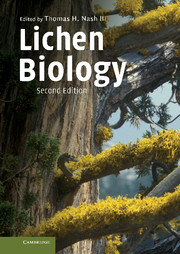Book contents
- Frontmatter
- Contents
- List of contributors
- Preface
- 1 Introduction
- 2 Photobionts
- 3 Mycobionts
- 4 Thallus morphology and anatomy
- 5 Morphogenesis
- 6 Sexual reproduction in lichen-forming ascomycetes
- 7 Biochemistry and secondary metabolites
- 8 Stress physiology and the symbiosis
- 9 Physiological ecology of carbon dioxide exchange
- 10 The carbon economy of lichens
- 11 Nitrogen, its metabolism and potential contribution to ecosystems
- 12 Nutrients, elemental accumulation, and mineral cycling
- 13 Individuals and populations of lichens
- 14 Environmental role of lichens
- 15 Lichen sensitivity to air pollution
- 16 Lichen biogeography
- 17 Systematics of lichenized fungi
- Appendix: Culture methods for lichens and lichen symbionts
- References
- Taxon index
- Subject index
7 - Biochemistry and secondary metabolites
Published online by Cambridge University Press: 05 September 2012
- Frontmatter
- Contents
- List of contributors
- Preface
- 1 Introduction
- 2 Photobionts
- 3 Mycobionts
- 4 Thallus morphology and anatomy
- 5 Morphogenesis
- 6 Sexual reproduction in lichen-forming ascomycetes
- 7 Biochemistry and secondary metabolites
- 8 Stress physiology and the symbiosis
- 9 Physiological ecology of carbon dioxide exchange
- 10 The carbon economy of lichens
- 11 Nitrogen, its metabolism and potential contribution to ecosystems
- 12 Nutrients, elemental accumulation, and mineral cycling
- 13 Individuals and populations of lichens
- 14 Environmental role of lichens
- 15 Lichen sensitivity to air pollution
- 16 Lichen biogeography
- 17 Systematics of lichenized fungi
- Appendix: Culture methods for lichens and lichen symbionts
- References
- Taxon index
- Subject index
Summary
Intracellular and extracellular products
There are two main groups of lichen compounds: primary metabolites (intracellular) and secondary metabolites (extracellular). Common intracellular products occurring in lichens include proteins, amino acids, polyols, carotenoids, polysaccharides, and vitamins, which are bound in the cell walls and the protoplasts, are often water-soluble, and can be extracted with boiling water (Fahselt 1994b). Some of these products are synthesized by the fungus and some by the alga. Since the lichen thallus is a composite structure, it is not always possible to decide where a particular compound is biosynthesized. Most of the intracellular products isolated from lichens are nonspecific, and also occur in free-living fungi, algae and in higher green plants (Hale 1983).The majority of organic compounds found in lichens are secondary metabolites of the fungal component, which are deposited on the surface of the hyphae rather than within the cells. These products are usually insoluble in water and can only be extracted with organic solvents. Carbon for the lichen is furnished primarily by the photosynthetic activity of the algal partner. Mosbach (1969) summarized the overall carbon metabolic sequence as involving photosynthesis in the photobiont followed by transport of the carbohydrate to the fungus, metabolism of the carbohydrate and subsequent biosynthesis of lichen secondary metabolites. The type of carbohydrate released by the alga and supplied to the fungus is determined by the photobiont, while in lichens containing cyanobacteria, the carbohydrate released and transferred to the fungus is glucose.
- Type
- Chapter
- Information
- Lichen Biology , pp. 104 - 133Publisher: Cambridge University PressPrint publication year: 2008
- 80
- Cited by

